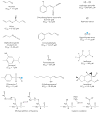Breathtaking TRP channels: TRPA1 and TRPV1 in airway chemosensation and reflex control
- PMID: 19074743
- PMCID: PMC2735846
- DOI: 10.1152/physiol.00026.2008
Breathtaking TRP channels: TRPA1 and TRPV1 in airway chemosensation and reflex control
Abstract
New studies have revealed an essential role for TRPA1, a sensory neuronal TRP ion channel, in airway chemosensation and inflammation. TRPA1 is activated by chlorine, reactive oxygen species, and noxious constituents of smoke and smog, initiating irritation and airway reflex responses. Together with TRPV1, the capsaicin receptor, TRPA1 may contribute to chemical hypersensitivity, chronic cough, and airway inflammation in asthma, COPD, and reactive airway dysfunction syndrome.
Figures



References
-
- Abe K, Watanabe N, Kumagai N, Mouri T, Seki T, Yoshinaga K. Circulating kinin in patients with bronchial asthma. Experientia. 1967;23:626–627. - PubMed
-
- Alarie Y. Irritating properties of airborne materials to the upper respiratory tract. Arch Environ Health. 1966;13:433–449. - PubMed
-
- Andre E, Campi B, Materazzi S, Trevisani M, Amadesi S, Massi D, Creminon C, Vaksman N, Nassini R, Civelli M, Baraldi PG, Poole DP, Bunnett NW, Geppetti P, Patacchini R. Cigarette smoke-induced neurogenic inflammation is mediated by alpha,beta-unsaturated aldehydes and the TRPA1 receptor in rodents. J Clin Invest. 2008 - PMC - PubMed
-
- Atzori L, Bannenberg G, Corriga AM, Lou YP, Lundberg JM, Ryrfeldt A, Moldeus P. Sulfur dioxide-induced bronchoconstriction via ruthenium red-sensitive activation of sensory nerves. Respiration. 1992;59:272–278. - PubMed
Publication types
MeSH terms
Substances
Grants and funding
LinkOut - more resources
Full Text Sources
Other Literature Sources
Medical

